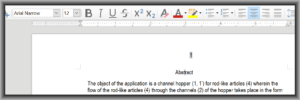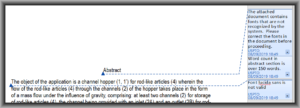One of the fundamental requirements in the design of an important system like USPTO’s system for e-filing patent applications is that the system should not force the customer to purchase any particular proprietary software as a precondition of use of the system.
USPTO’s initiative to try to force customers to file patent applications in DOCX format is an example of a failure to satisfy that requirement.
USPTO states, disingenuously:
DOCX is supported by many popular word processing applications, such as Microsoft Word, Google Docs, and LibreOffice.
There is not, in fact, any single DOCX standard. Most word processors follow a fairly well standardized version of the DOCX format, but Microsoft’s word processor follows Microsoft’s usual pattern of “embracing and extending” any industry standard with which it comes in contact.
The USPTO patent e-filing system calls for the user to upload a DOCX file for a specification, claims, or abstract. It carries out some processing of the DOCX file, and if the DOCX file passes USPTO’s scrutiny, the e-filing system “renders” the file as a PDF. The e-filing system then tells the user that the user must inspect the PDF file. If the user clicks “submit”, the user is deemed to have agreed that the PDF file is the official file.
Importantly, if at some later time it becomes clear that the USPTO system introduced errors into the PDF file, the user is not permitted to point to the original DOCX file (as rendered by the user’s word processor) as the authoritative document. The USPTO’s position is that the corrupted PDF file on which the user clicked “submit” is the authoritative document.
Imagine filing a patent application at 11PM on the last possible day, and the message appears on the screen that the user must now proofread a PDF generated by the USPTO to see if it contains errors introduced by the USPTO. This is not an idle or hypothetical problem; see this blog article which gives an actual example in which the USPTO system corrupted a math equation in a patent application, changing the number “0” to the number “10”.
But the point of this blog article is to point out that it is clear that USPTO never actually tested its DOCX e-filing system with any word processor other than Microsoft Word. And the software in USPTO’s e-filing system fails to handle correctly even a very simple DOCX file created using Libre Office. It is recalled (see above) that Libre Office is one of the word processors that USPTO points to as (supposedly) being supported by USPTO in its patent e-filing system.

Here is the source file for a real-life example that I attempted to e-file today. It is an abstract, edited in Libre Office. As may be seen the font is “arial narrow” which is one of the fonts that USPTO says is acceptable for DOCX patent application filing.

But when one uploads the DOCX file into EFS-Web or into Patentcenter, the USPTO system pukes on the file, stating (falsely) that the DOCX file contains a font called “lucida sans”. Here you can see the error message.
I will mention that in this case, the USPTO also introduced another corruption into the DOCX file, changing the font of the word “Abstract” to be “calibri”.
This extremely simple word processor file contains no exotic characters, no Greek letters, no math equations, no chemical formulas. It contains only text. Had it been created using Microsoft Word, there is no doubt USPTO’s e-filing system would have accepted and indeed welcomed the DOCX file. (I know this is true because I tried it in Microsoft Word and USPTO’s system welcomed the DOCX file.)
But what I did today, that exposed this problem in USPTO’s e-filing system, was to use a word processor other than Microsoft Word to generate my DOCX file. I used Libre Office. And USPTO’s system corrupted the file (changing a font) and puked on it (stating falsely that I had used a font called “lucida sans”).
From this it is quite clear that USPTO never tested its e-filing system to see if it would handle correctly the versions of DOCX format generated by word processors other than Microsoft Word.
This would not be so bad if DOCX filing were purely optional. But USPTO has proposed to start penalizing customers who e-file patent applications in formats other than DOCX. A $400 penalty would be imposed so as to “incentivize” customers to file in DOCX format.
USPTO needs to put its proposed $400 penalty “on hold” until after it fixes its e-filing system so that it will work correctly with DOCX files generated by word processors other than Microsoft Word.

Carl, I would be happy to collaborate with you and David Boundy to challenge promulgation of the proposed “docx” requirement and non-DOCX surcharge. I am a member of the EDVA bar where such a complaint should be filed. Your blog post above is evidence relevant to such a challenge.
My experience with the docx, as implemented by the USPTO, is very, very bad. On top if this, it is unthinkable that the USPTO, which is a government agency, will give priority to a private company (Microsoft), and worse, a company that has repeatedly worked against the common users, as Microsoft have constantly done from the beginning. To add insult to injury, any software savvy person knows that Microsoft software is technically a disgrace, an inferior product. I am just a retired professor of physics, neither a lawyer nor a politician, I do not know how to solve the problem, but a problem it is – from the technical point of view.
From a technical point-of-view, perhaps a *.txt file would help the applicants, together with a check-sum file to guarantee that the file is not corrupted. Perhaps it could be a last resort document, that would document the intended words of the applicant. Also, there is no technical reason to charge the applicant to send both a *pdf and a *.txt file AND store both at the USPTO computer servers! The storage space would be minimal, not worth the energy and work to charge the applicant. There is no technical reason to charge to store such a small file together with the patent application.
I hope that your guys succeed in forcing the USPTO to straighten its act up.